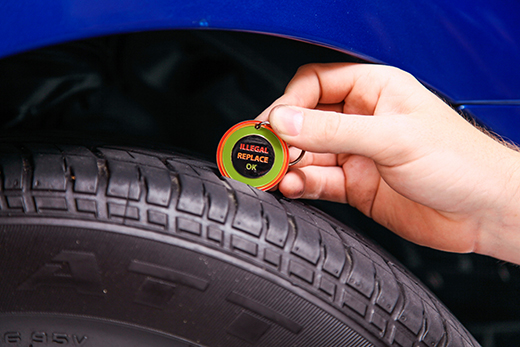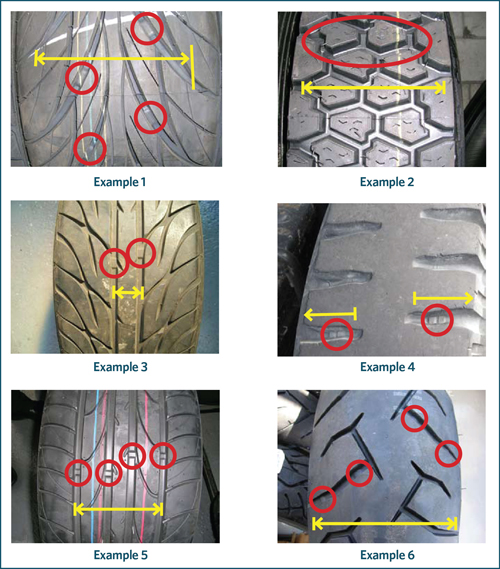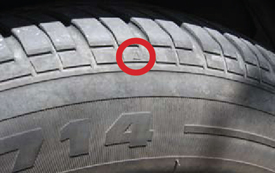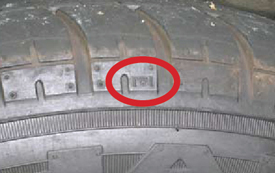You need to choose the tyres that are right for your vehicle and the driving you do. No tyre is perfect for all driving conditions. Talk to an expert about how and where you regularly drive so they can advise on the tyres you might need.
Most tyre manufacturers recommend placing the tyres with the best grip at the rear, whether the car is front or rear wheel drive. Fitting tyres with less grip to the rear of a vehicle can result in over-steer and loss of control. It is best to replace your tyres in sets of four (or at least in pairs on the same axle) to maintain consistent handling.
Car manufacturers recommend that replacement tyres be the same type as those originally fitted, to maintain all-round driving performance.
Regularly check your tyres to make sure there is plenty of tread. The minimum legal depth is 1.5mm but the more tread you have the better the grip and the safer you'll be.
The image below shows how much a tyre touches a wet road at different speeds. The faster you go, the less effective your tyres will be if the tread depth isn’t up to scratch.

Because it's the only part of the vehicle that grips the road, the depth of tread on your tyres is very important for the safety of your vehicle. Checking your tyre tread depth is easy and only takes a few minutes. You can use a tyre tread depth checker/gauge yourself or go to a local garage and get them to check it for you.

Most tyres have moulded tread-depth indicators which are flush with the tyre tread when it has reached the minimum depth. The minimum legal tread depth is 1.5mm within all principal grooves that contain these moulded tread depth indicators. These must be at least 1.5mm around the whole circumference of the tyre.
Principal grooves are the wide grooves in the tyre tread which have the tread-depth indicators located inside them. Any other grooves are secondary grooves which may wear out during the service life of the tyre.
The following shows different tread patterns with tread-depth indicators (and therefore principal grooves) and the width where you should measure marked.
 If you find it difficult to find tread-depth indicators, just look along the side wall for a small '
If you find it difficult to find tread-depth indicators, just look along the side wall for a small '![]() ' or 'TWI' (tread wear indicator) mark (see below pictures).
' or 'TWI' (tread wear indicator) mark (see below pictures).


If you can see any worn, damaged or exposed cords (steel from within the tyre) take it to an expert immediately.
Maintaining correct tyre pressure ensures balanced braking, maximum grip and long tyre life. Legally, you need to keep your tyres at the pressure recommended by the vehicle manufacturer.
Tyres naturally lose a little air pressure over time so it's worth checking them every month or so, for example whenever you're filling up.
Having the correct tyre pressure helps improve safety, handling, fuel efficiency and extends tyre life. Correct tyre pressure can help reduce fuel consumption by up to 4%.
You can find your car's correct tyre pressure either on the inside of the driver's door, in the handbook or by checking the EECA's tyre pressure tool(external link). Don't forget to make sure your spare wheel or space saver wheel is inflated to the correct pressure too.
Proper tyre inflation pressure is essential for safety, fuel economy and tyre wear.
Check your tyre pressure while tyres are cold.
EECA's tyre pressure tool(external link)
Always check with a tyre specialist before changing an original rim or manufacturer-fitted tyre. Fitting tyres with a different diameter to the originals will affect the accuracy of the speedometer and odometer which can have an effect on your safety. If you fit wider wheels and tyres, increasing the wheel offset beyond 25mm overall, you'll need to get your vehicle certified by a low volume certifier(external link).
The life and performance of your tyres depend largely on how you treat them. Safe driving, regular inspections and rotating tyres (around the car for even wear) are essential for safety.
Correctly balanced wheels will ensure smooth and vibration-free running and improve tread life, as well as extending the life of your car's suspension and steering components.
Tyre repairs legally have to return tyres to 'within safe tolerance' of when they were manufactured. Approved vehicle standards will apply.
Approved vehicle standards also set out which parts of the tyre are suitable for repair.
Many garages sell 'string repair' kits or sealants as a quick-fix solution for tyre punctures. Use these as temporary measures only, to get home or to a repair service. Drive slowly and for a short distance.
Motorcycle tyre manufacturers recommend that when fitting new tubed type tyres, new inner tubes should be fitted for safety reasons.
Some high performance tyres have asymmetrical treads to provide improved handling and performance. These tyres have an inside and an outside tread pattern so that the pattern is not symmetrical across the tread width and must be fitted to match one particular side of the tyre with the corresponding side of the rim, as marked on the tyre. If moving these tyres from one side of your car to the other the tyres must not be removed from the rims and turned around as this will create a tyre/rim mismatch.
Many modern cars are equipped with 'temporary-use' or space-saver spare tyres that are smaller and lighter than standard spares. These tyres are usually about the width of a motorcycle tyre. They are safe to drive on as long as they are in good condition and you keep to the guidelines below - but their main use is to get you to a place where you can replace or repair the proper tyre.
Keep space-saver tyres inflated to the pressure indicated on the wheel label.
Use space-saver tyres only in an emergency - they're not designed to be used over long distances.
Drive carefully and at no more than 80km/h when using a space-saver tyre. Your car's handling may be different when one is fitted.
Never fit more than one space-saver tyre to a vehicle.
Download our winter tyres pamphlet for more information [PDF, 1 MB]